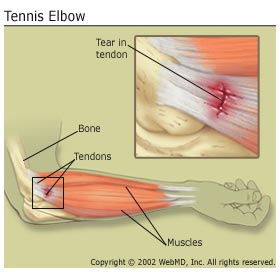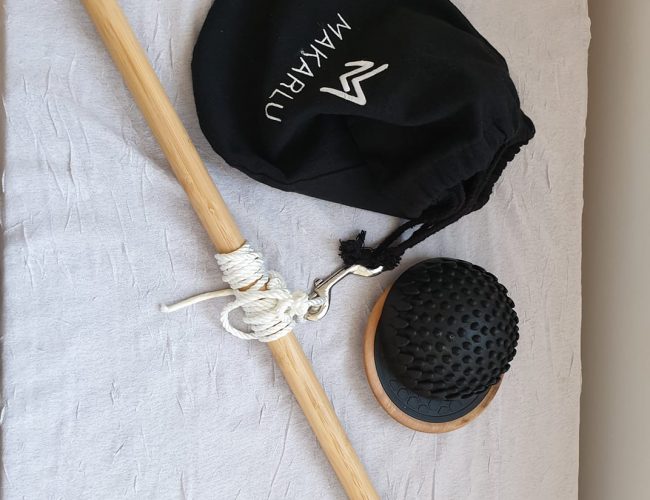Tennis Elbow – lateral epicondylitis
Wed,Aug 07, 2019 at 08:05AM by Carla Mullins
Tennis elbow is quite a common injury not just amongst tennis players but among many people who have fixed grip positions eg pilates teachers who are constantly changing springs. The conditions other name is lateral epicondylitis, but i must admit everytime I hear the term I think that it is the name of a slavic tennis player Tennis elbow is essentially associated with overuse of certain muscles in specific holding patterns. In this article we will explore :
// Anatomy of the elbow, the muscles and joints
// a review of the tendons
// the symptoms of tennis elbow
// exercise considerations and progression
An anatomy review
The elbow is a confusing little joint for most people because there is explanations of strange named bones references to lateral and medial and it is all quite hard to orientate yourself in space. Accordingly, in this article we are going to start with the basics of the elbow joint and the muscles. The way I like to think about anatomy of the arm is that the anatomy names were given on the basis of how people were lying on a “slab” ready for anatomical dissection. Yes it does sound a bit gruesome but essentially if you stand up and have your palms facing forward this is called anatomical position, and the term lateral or medial describes the relative placement of a limb to the midline of the body on that basis.
My suggestion is that you hold your arms out with your palms forward and write an M on the medial side ( that is the part closes to the body) and an L on the lateral side, of both the part of the arm near your elbow and the part of your arm near your hand . Then as you move your hand from front to back (pronation) notice how the elbow M does not change but the hand M changes to the lateral side.
Love me Tendon is a workshop I teach about tendons, and their role. In this I give more of an explanation of tendons and how they work, for those of you who like video explanations.
What is a tendinopathy?
Put simply, the term tendinopathy describes the clinical conditions associated with overuse in and around tendons.
Tendons can be damaged at the:
// Insertion point to the bone;
// Belly of the tendon;
// Attachment point to the muscle.
Tendon pathology has been described as a continuum (Cook & Purdam 2009) with three distinct stages:
// Reactive tendinopathy;
// Tendon disrepair;
// Degenerative tendinopathy.
Tendon repair means that when a tendon is healing it will lay down new collagen fibres to build and replace the damaged fibres of the tendon. The important thing to remember is that when healing the collagen fibres can become disorganised which can mean that the tendon looses some of its tensile strength. I like to see this repair process as a scar on the tissue and if the scar is not managed and moved correctly it can become a scar that puckers and limits the tendon in future movements. It is important that when working the muscles and tendons to incorporate new load that the load is encouraged in the line of the tendon, so that the fibres build up in an organised manner,
From a pilates and exercise perspective, it is important to note that load is considered to be the primary stimulus which drives tendon health forward and back along the continuum.
// Low load will result in the tendon decreasing in size or furthering into degeneration;
// High load will result in inflammation or further tendon degeneration;
// The “Goldilocks Zone” will result in tendon growth and repair.
Pain response to loading is the current gold standard for measuring what load is suitable for a particular stage of degeneration. The table below illustrates how load can help to create a healthy tendon response, with the “Goldilocks Zone” marked A.

Source: Orthopaedic Journal of Sports Medicine (Nov 2016)
Load, progression and the continuum
Within the constraints of recovery proposed by Cook & Purdam (2009), relative rest or load adjustment may allow the tendon to return to a previous level of structure and capacity within the continuum. Remember also that the role of a tendon is to distribute tension from the muscle. When the tendon is not working the load response is not appropriate.
When a physiotherapist discusses load they will consider a number of factors:
Exercise type
// Open versus Closed chain;
// Eccentric versus Concentric;
// Isometric versus Dynamic;
// Number of repetitions;
// Degree of resistance.
Stage of disrepair
// Degenerative tendinopathies will react better to eccentric exercise based intervention. Tendons respond better to work than rest
Pharmacotherapies
// Therapy using pharmaceutical drugs, as distinguished from therapy using surgery, radiation, movement;
// Examples are NSAIDS or pain medication.
When working with a physiotherapist, a movement teacher and client need to be aware of these considerations and how they are going to affect decisions about the staging of movement and exercise in order to achieve tendon repair and balanced movement.
Staging and a protocol for tendon repair
Staging of the appropriate load in exercises and movements is an important aspect of tendon recovery. A decision is made on how load-tolerant a tendon would be includes an identification of where the person is within these stages:
// Stage One: Is the person presenting as intolerant to load, i.e. are they showing a painful response to any load?
// Stage Two: Is the person presenting as load tolerant, i.e. manages to achieve a positive response to slow speed and high load, e.g. standing on one leg?
// Stage Three: Is the person presenting as load tolerant to fast speed and high load (energy storage) e.g. carrying the shopping?
Being specific with the appropriate degree of load can become an art form, as there are many factors individual to each person to consider. Factors such as fear, pain, apprehension and inflammatory response may all affect the person’s ability to transit from one stage to the next.
When working with tendon pathology we need to appreciate there are stages to recovery specific to the muscle and tendon affected. Accordingly, we need to identify the staging for that muscle and tendon and incorporate this into the appropriate steps of a pilates program.
When working in a pilates studio I think that the principles of pilates of alignment, control and precision all come to the fore when dealing with tendon issues.
Symptoms of Tennis elbow include:
//elbow pain that gradually gets worse
//tenderness at the lateral Epicondylitis
// radiating pain from the lateral aspect of the elbow to the forearm and back of the hand
// weak grip
// decreased range of movement and soft tissue tightness with elbow extension with finger flexion and ulnar deviation
// there is also pain near the elbow when the wrist is extended against resistance ( bent backwards like revving a handle on a motorbike)
Some exercise considerations for Tennis elbow
When working with tennis elbow it is important to remember:
// the principles of tendon damage and repair
// support the joint, with the spring /load close to the tendon at first and then slowly progress the load further out. eg pilates cuff arm exercise in the video below, to help encourage shoulder placement and unload the joints whilst building strength in the stabilising muscles.
// strengthening the muscles particular the extensors of the elbow and shoulder , read triceps on equipment like the arm chair. I also love a properly done hug a tree, see video below.
// supination and pronation exercises for the hands and forearm, some of the ideas are discussed in the makarlu hand and wrist video below.
// use of a bean bag, and I particularly like how a lovely teacher in Sydney innovated the use of the traditional bean bag to a more graded option using makarlu

The Makarlu bag is clipped to string which is attached to a dowel. You can grade the bag by using different components of the Makarlu as the person’s strength and tolerance increases
Body Organics provides a multi disciplinary service in Brisbane, with a focus on high quality movement training in conjunction with allied and Complementary health practitioners. Body Organics Education provides education in Australian, NZ, Europe, and the Americas. Training in other parts of the world can be accommodated on request.
To buy Makarlu ( which is shipped throughout the world) . Shop now at makarlu.com
 0
0 